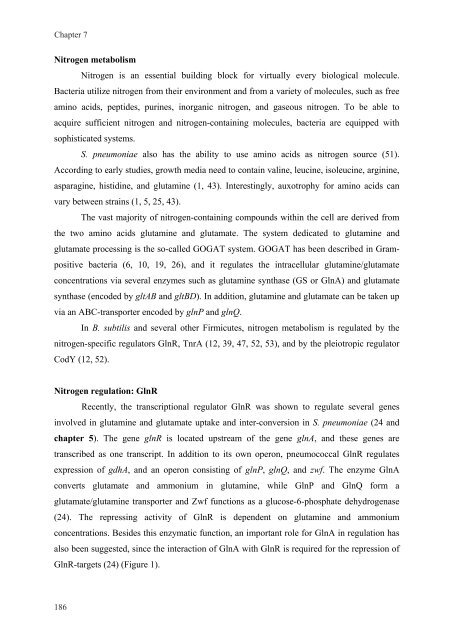Gene regulation in Streptococcus pneumoniae - RePub - Erasmus ...
Gene regulation in Streptococcus pneumoniae - RePub - Erasmus ...
Gene regulation in Streptococcus pneumoniae - RePub - Erasmus ...
You also want an ePaper? Increase the reach of your titles
YUMPU automatically turns print PDFs into web optimized ePapers that Google loves.
Chapter 7<br />
Nitrogen metabolism<br />
186<br />
186<br />
Nitrogen is an essential build<strong>in</strong>g block for virtually every biological molecule.<br />
Bacteria utilize nitrogen from their environment and from a variety of molecules, such as free<br />
am<strong>in</strong>o acids, peptides, pur<strong>in</strong>es, <strong>in</strong>organic nitrogen, and gaseous nitrogen. To be able to<br />
acquire sufficient nitrogen and nitrogen-conta<strong>in</strong><strong>in</strong>g molecules, bacteria are equipped with<br />
sophisticated systems.<br />
S. <strong>pneumoniae</strong> also has the ability to use am<strong>in</strong>o acids as nitrogen source (51).<br />
Accord<strong>in</strong>g to early studies, growth media need to conta<strong>in</strong> val<strong>in</strong>e, leuc<strong>in</strong>e, isoleuc<strong>in</strong>e, arg<strong>in</strong><strong>in</strong>e,<br />
asparag<strong>in</strong>e, histid<strong>in</strong>e, and glutam<strong>in</strong>e (1, 43). Interest<strong>in</strong>gly, auxotrophy for am<strong>in</strong>o acids can<br />
vary between stra<strong>in</strong>s (1, 5, 25, 43).<br />
The vast majority of nitrogen-conta<strong>in</strong><strong>in</strong>g compounds with<strong>in</strong> the cell are derived from<br />
the two am<strong>in</strong>o acids glutam<strong>in</strong>e and glutamate. The system dedicated to glutam<strong>in</strong>e and<br />
glutamate process<strong>in</strong>g is the so-called GOGAT system. GOGAT has been described <strong>in</strong> Grampositive<br />
bacteria (6, 10, 19, 26), and it regulates the <strong>in</strong>tracellular glutam<strong>in</strong>e/glutamate<br />
concentrations via several enzymes such as glutam<strong>in</strong>e synthase (GS or GlnA) and glutamate<br />
synthase (encoded by gltAB and gltBD). In addition, glutam<strong>in</strong>e and glutamate can be taken up<br />
via an ABC-transporter encoded by glnP and glnQ.<br />
In B. subtilis and several other Firmicutes, nitrogen metabolism is regulated by the<br />
nitrogen-specific regulators GlnR, TnrA (12, 39, 47, 52, 53), and by the pleiotropic regulator<br />
CodY (12, 52).<br />
Nitrogen <strong>regulation</strong>: GlnR<br />
Recently, the transcriptional regulator GlnR was shown to regulate several genes<br />
<strong>in</strong>volved <strong>in</strong> glutam<strong>in</strong>e and glutamate uptake and <strong>in</strong>ter-conversion <strong>in</strong> S. <strong>pneumoniae</strong> (24 and<br />
chapter 5). The gene glnR is located upstream of the gene glnA, and these genes are<br />
transcribed as one transcript. In addition to its own operon, pneumococcal GlnR regulates<br />
expression of gdhA, and an operon consist<strong>in</strong>g of glnP, glnQ, and zwf. The enzyme GlnA<br />
converts glutamate and ammonium <strong>in</strong> glutam<strong>in</strong>e, while GlnP and GlnQ form a<br />
glutamate/glutam<strong>in</strong>e transporter and Zwf functions as a glucose-6-phosphate dehydrogenase<br />
(24). The repress<strong>in</strong>g activity of GlnR is dependent on glutam<strong>in</strong>e and ammonium<br />
concentrations. Besides this enzymatic function, an important role for GlnA <strong>in</strong> <strong>regulation</strong> has<br />
also been suggested, s<strong>in</strong>ce the <strong>in</strong>teraction of GlnA with GlnR is required for the repression of<br />
GlnR-targets (24) (Figure 1).

















